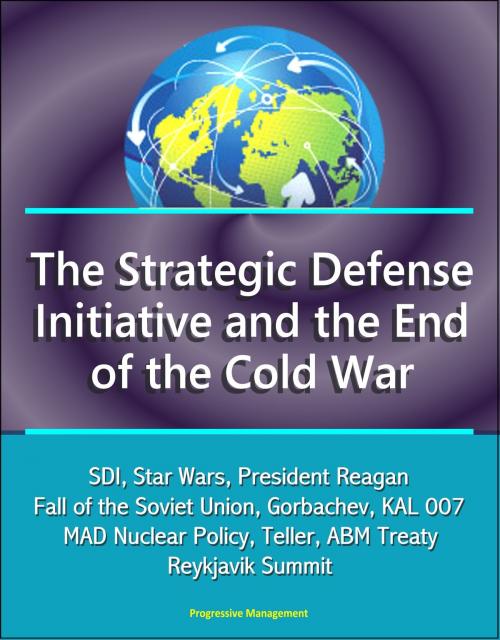The Strategic Defense Initiative and the End of the Cold War: SDI, Star Wars, President Reagan, Fall of the Soviet Union, Gorbachev, KAL 007, MAD Nuclear Policy, Teller, ABM Treaty, Reykjavik Summit
Nonfiction, History, Military, Nuclear Warfare| Author: | Progressive Management | ISBN: | 9781311960030 |
| Publisher: | Progressive Management | Publication: | May 29, 2014 |
| Imprint: | Smashwords Edition | Language: | English |
| Author: | Progressive Management |
| ISBN: | 9781311960030 |
| Publisher: | Progressive Management |
| Publication: | May 29, 2014 |
| Imprint: | Smashwords Edition |
| Language: | English |
This is a fascinating historic analysis of the fall of the Soviet Union and the end of the Cold War. The Cold War's end was sudden, unpredicted and the seminal event of the latter half of the twentieth century. Since the disintegration of the USSR, debate has centered on whom or what was responsible for the end of the conflict. Perhaps no issue is as controversial as the role the U.S. Strategic Defense Initiative (SDI) played in ending the Cold War. Today, there are three main schools of thought concerning SDI's impact on the end of the Cold War. The first sees the Strategic Defense Initiative as a primary factor in ending the conflict. Another argues the initiative extended the Cold War by creating one more hurdle to the negotiations between the two superpowers. A third school holds that while SDI had a positive impact on ending the Cold War, it was a secondary factor. The third school's position is best supported by the available evidence.
All of the arguments stem from several key questions. The central issue concerns the question, What drove Gorbachev's decision to exit the Cold War? This thesis rephrases that question more narrowly: What were the primary influences that motivated Gorbachev to sign the Treaty Between the United States of America and the Union of Soviet Socialist Republics on the Elimination of Their Intermediate-Range and Shorter-Range Missiles, (INF Treaty) — which arguably ended the conflict — and to what degree were they instrumental in its signing? Additional questions that will be addressed include the following: Did either the Soviet Union's investment in developing countermeasures to the U.S. defense initiative or its own ballistic missile defense (BMD) system severely strain the Soviet economy? Did Soviet fear of losing a new arms race in light of their economic and technological backwardness, as compared to the West, push them to negotiate? Were there other factors that would have driven Gorbachev to exit the Cold War regardless of the Strategic Defense Initiative?
CHAPTER I - THE ROLE OF THE STRATEGIC DEFENSE INITIATIVE IN ENDING THE COLD WAR * CHAPTER II - THE END OF THE COLD WAR AND SCHOOLS OF THOUGHT ON SDI * A. INTRODUCTION * B. THE END OF THE COLD WAR * C. THREE SCHOOLS OF THOUGHT ON SDI'S ROLE IN ENDING THE COLD WAR * D. CONCLUSION * CHAPTER III - PRESIDENT REAGAN AND THE STRATEGIC DEFENSE INITIATIVE * A. INTRODUCTION * B. THE STATUS QUO * C. REAGAN'S FOREIGN POLICY PLAN * D. THE STRATEGIC DEFENSE INITIATIVE AND REJECTION OF MUTUALLY ASSURED DESTRUCTION * E. A PUSH FOR DIALOGUE * F. CONCLUSION * CHAPTER IV - INITIAL REACTIONS: MARCH 1983-MARCH 1985 * A. INTRODUCTION * B. GENERAL SECRETARY * C. THE NATIONAL SECURITY COMMUNITY * D. CONCLUSION * CHAPTER V - ENTER GORBACHEV: MARCH 1985-OCTOBER 1986 * A. INTRODUCTION * B. GENERAL SECRETARY * C. NATIONAL SECURITY COMMUNITY * D. CONCLUSION * CHAPTER VI * EXITING THE COLD WAR: NOVEMBER 1986-DECEMBER 1987 * A. INTRODUCTION * B. GENERAL SECRETARY * C. THE NATIONAL SECURITY COMMUNITY * D. CONCLUSION * CHAPTER VII - ASSESSMENT OF THE ROLE OF SDI IN THE END OF THE COLD WAR * A. INTRODUCTION * B. THE PRO-SDI SCHOOL * C. THE ANTI-SDI SCHOOL * D. SDI WAS A SECONDARY FACTOR
This is a fascinating historic analysis of the fall of the Soviet Union and the end of the Cold War. The Cold War's end was sudden, unpredicted and the seminal event of the latter half of the twentieth century. Since the disintegration of the USSR, debate has centered on whom or what was responsible for the end of the conflict. Perhaps no issue is as controversial as the role the U.S. Strategic Defense Initiative (SDI) played in ending the Cold War. Today, there are three main schools of thought concerning SDI's impact on the end of the Cold War. The first sees the Strategic Defense Initiative as a primary factor in ending the conflict. Another argues the initiative extended the Cold War by creating one more hurdle to the negotiations between the two superpowers. A third school holds that while SDI had a positive impact on ending the Cold War, it was a secondary factor. The third school's position is best supported by the available evidence.
All of the arguments stem from several key questions. The central issue concerns the question, What drove Gorbachev's decision to exit the Cold War? This thesis rephrases that question more narrowly: What were the primary influences that motivated Gorbachev to sign the Treaty Between the United States of America and the Union of Soviet Socialist Republics on the Elimination of Their Intermediate-Range and Shorter-Range Missiles, (INF Treaty) — which arguably ended the conflict — and to what degree were they instrumental in its signing? Additional questions that will be addressed include the following: Did either the Soviet Union's investment in developing countermeasures to the U.S. defense initiative or its own ballistic missile defense (BMD) system severely strain the Soviet economy? Did Soviet fear of losing a new arms race in light of their economic and technological backwardness, as compared to the West, push them to negotiate? Were there other factors that would have driven Gorbachev to exit the Cold War regardless of the Strategic Defense Initiative?
CHAPTER I - THE ROLE OF THE STRATEGIC DEFENSE INITIATIVE IN ENDING THE COLD WAR * CHAPTER II - THE END OF THE COLD WAR AND SCHOOLS OF THOUGHT ON SDI * A. INTRODUCTION * B. THE END OF THE COLD WAR * C. THREE SCHOOLS OF THOUGHT ON SDI'S ROLE IN ENDING THE COLD WAR * D. CONCLUSION * CHAPTER III - PRESIDENT REAGAN AND THE STRATEGIC DEFENSE INITIATIVE * A. INTRODUCTION * B. THE STATUS QUO * C. REAGAN'S FOREIGN POLICY PLAN * D. THE STRATEGIC DEFENSE INITIATIVE AND REJECTION OF MUTUALLY ASSURED DESTRUCTION * E. A PUSH FOR DIALOGUE * F. CONCLUSION * CHAPTER IV - INITIAL REACTIONS: MARCH 1983-MARCH 1985 * A. INTRODUCTION * B. GENERAL SECRETARY * C. THE NATIONAL SECURITY COMMUNITY * D. CONCLUSION * CHAPTER V - ENTER GORBACHEV: MARCH 1985-OCTOBER 1986 * A. INTRODUCTION * B. GENERAL SECRETARY * C. NATIONAL SECURITY COMMUNITY * D. CONCLUSION * CHAPTER VI * EXITING THE COLD WAR: NOVEMBER 1986-DECEMBER 1987 * A. INTRODUCTION * B. GENERAL SECRETARY * C. THE NATIONAL SECURITY COMMUNITY * D. CONCLUSION * CHAPTER VII - ASSESSMENT OF THE ROLE OF SDI IN THE END OF THE COLD WAR * A. INTRODUCTION * B. THE PRO-SDI SCHOOL * C. THE ANTI-SDI SCHOOL * D. SDI WAS A SECONDARY FACTOR















